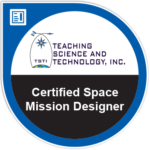Empower Project Success
with TSTI as your systems engineering and project management training, coaching, and consulting partner.
Designing Space Missions & Systems
An Integrated Systems Engineering Approach
Course Description:
This course examines the real-world application of the entire space systems engineering discipline. Taking a process-oriented approach, the course starts with basic mission objectives and examines the principles and practical methods for mission design and operations in depth. Discussions focus on initial requirements definition, operations concept development, architecture trade-offs, payload design, bus sizing, subsystem definition, system manufacturing, verification and operations. Most of the material presented in this course comes from Space Mission Analysis and Design. This is a hands-on course with a focus on applications. The content is presented in a 13 week format with detailed homework sets in a design exercise format to give first-hand experience with the techniques presented. With over 3,000 alumni, this course is designed for systems engineers and project managers who are responsible for the detailed design and operation of space systems.
Course Objectives:
At the end of this course you will have the knowledge, tools and experience to start with a blank sheet of paper and design an effective space mission to meet a broad set of objectives, or critically analyze proposed mission designs with insight into the critical trade-offs between cost, schedule, performance and risk. You’ll walk away with….
- An enhanced understanding of the big picture of space missions and systems

- A detailed working knowledge of how all the elements of a space mission work and the key trades that lead to a successful mission
- Practical experience with applying systems engineering processes to develop conceptual designs for space missions and systems
- An organized framework for future space learning—on your own, in academic courses, or other short courses
- Earn 80% on the final exam and receive our Certified Space Mission Designer digital badge that can be shared on social media
Course Topics:
- Applied Space Systems Engineering
- Space Mission Design (FireSAT Example)
- Mission Scope and ConOps
- Mission-level Trade-offs
- Design Solutions and Requirements Capture
- Orbits & Trajectories
- Launch & Space Environments
- Understanding Orbits, Describing & Using Orbits
- Orbit Maneuvers and Orbit Design
- Ascent/Entry
- Launch System Services
- Derived Requirements and Critical Interfaces
- Induced Environments
- Spacecraft Engineering
- Spacecraft Architecture Definition
- Payload Design
- Derived & Allocated Requirements
- Functional Architecture & ConOps
- Basic Principles, Current Technologies
- Physical Architectures & Interfaces
- Spacecraft Allocated Architecture
- Subsystem Design (Power, ADCS/GNC, Comm, Propulsion, CDH, Thermal, Structures/Configuration)
- System Realization
- System Implementation (buy, build, re-use)
- Integration, Verification & Validation, Transition
- Mission Operations Systems
- Functional Architecture
- Physical Architecture Options
- Complexity Drivers
- Mission Evaluation
- Technical Risk Assessment and Cost Estimation
Unique Features of Online Course
- 23 guided lectures – presented by several of TSTI’s award winning instructors; the equivalent of a semester-long course
- Continuous feedback on your progress through lesson review questions, quizzes and exams
- Explore topics in depth via two part homework set to apply what you’ve learned each step of the way
- 100% self-paced – you have up to 6 months to complete the course on your own time when it is convenient for you!
- 24/7 access to all course material through our exclusive learning management system
- Certificate of Completion with 12 Continuing Education Units (CEUs)

